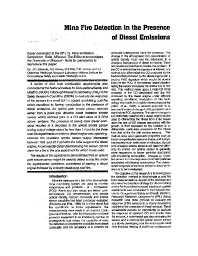Mining Publication: Mine Fire Detection in the Presence of Diesel Emissions
Original creation date: June 1999
A series of four coal combustion experiments was conducted at the National Institute for Occupational Safety and Health's (NIOSH) Pittsburgh Research Laboratory (PRL) in the Safety Research Coal Mine (SRCM) to evaluate the response of fire sensors to a small 0.61 m square smoldering coal fire which transitions to flaming combustion in the presence of diesel emissions. An optical path smoke sensor alarmed earlier than a point type diffusion mode ionization smoke sensor, which alarmed prior to a CO alert value of 5 PPM above ambient. The presence of steady state diesel emissions resulted in a decrease in the optical smoke sensor analog output voltage signal by less than 1.4 pct for the three coal fire experiments in which a diesel engine was operating, whereas the ionization smoke sensor output decreased between 10.8 and 26.7 pct after the initial surge of the diesel engine. A commercial diesel discriminating fire sensor did not alarm for a fire in the one experiment for which it was used. The results of the experiments demonstrated that an optical path smoke sensor might be used to detect a coal fire under the experimental conditions considered of starting a diesel engine followed by a slowly developing coal fire.
Authors: JC Edwards, RA Franks, GF Friel, CP Lazzara, JJ Opferman
Conference Paper - June 1999
NIOSHTIC2 Number: 20024560
Proc Eighth U.S. Mine Ventilation Symposium. Rolla, MO: University of Missouri-Rolla, Press, 1999 Jun; :295-301
See Also
- Fire Response Preparedness for Underground Mines
- In Mine Evaluation of Discriminating Mine Fire Sensors
- In-Mine Evaluation of Smart Mine Fire Sensor
- Mine Fire Detection in the Presence of Diesel Emissions
- Multiple Type Discriminating Mine Fire Sensors
- Neural Network Application to Mine-Fire Diesel-Exhaust Discrimination
- Overview of Mine Fire Detection
- Real-time Neural Network Application to Mine Fire - Nuisance Emissions Discrimination
- Technology News 498 - Multiple Fire Sensors for Mine Fire Detection and Nuisance Discrimination
- Understanding Mine Fire Disasters by Determining the Characteristics of Deep-Seated Fires
- Page last reviewed: 9/21/2012
- Page last updated: 9/21/2012
- Content source: National Institute for Occupational Safety and Health, Mining Program


 ShareCompartir
ShareCompartir
